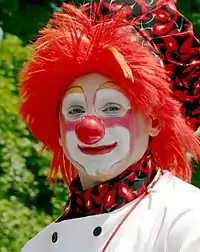Clown Care
Clown Care, also known as hospital clowning, is a program in health care facilities involving visits from specially trained clowns. They are colloquially called "clown doctors" which is a trademarked name in several countries. These visits to hospitals have been shown to help in lifting patients' moods with the positive power of hope and humor. There is also an associated positive benefit to the staff and families of patients.[1]

Background
Patch Adams, considered the first hospital clown, started being a hospital clown in the 1970s. He was portrayed in the movie Patch Adams by Robin Williams, bringing attention to hospital clowning.[2]
Professional Clown Doctors began working in hospitals in 1986 under a program called the Big Apple Circus Clown Care Unit, which was started by Michael Christensen in New York City. Clown Doctor programs now operate in every state in Australia, New Zealand,[3] the United States, the United Kingdom, Canada, Israel, South Africa, Hong Kong, Brazil, Belarus, Taiwan[4] and all over Europe and in some parts of India.[2]
Clown Doctors attend specifically to the psycho-social needs of the hospitalized child but in some hospitals they also visit adults.[5] They parody the hospital routine to help children adapt to their surroundings, they also distract from and demystify painful or frightening procedures.[6] The atmosphere of fun and laughter can help children forget about the illness and the stress for a moment.
Clown Doctors use techniques such as magic, music, storytelling and other clowning skills to empower children with doses of fun that help them deal with the range of emotions they may experience while in hospital: fear, anxiety,[7][8] loneliness, boredom.
The healing power of humor and laughter combats stress, reduces pain by releasing endorphin (the body's natural painkiller), boosts the immune system by increasing the level of T cells & lowering serum cortisol levels, helps promote a positive outlook, helps people to cope with difficult situations and helps to create bonds and therefore support between people, all of which aids the healing process. According to Tan, Metsälä, and Hannula,[9] "Clown care creates a positive emotional state, promotes interaction between parents and child, and fosters affirmative environmental conditions."
Research on the physiological health benefits on laughter has been conducted for decades and continues to be carried out by medical physicians internationally. There is also a growing group of researchers that are exploring the psychological benefits of laughter, and specifically the work of Clown-Doctors.[10][11][12]
References
- Battrick, Cath; Glasper, Edward Alan; Prudhoe, Gill and Weaver, Katy. 2007. “Clown Humour: The Perceptions of Doctors, Nurses, Parents and Children.” Journal of Children's and Young People's Nursing 1(4): 174-179.
- Farrell, Melinda. "History of Clowning". Humour Foundation. Archived from the original on 2017-01-05. Retrieved 2017-01-14.
- Mora, Jim. July 14, 2009. "Clown Doctors." Radio New Zealand National interview
- "紅鼻子醫生 Dr.Rednose – 台灣唯一專業中立的小丑醫生組織" (in Chinese). Retrieved 2020-10-12.
- Nuttman-Shwartz, Orit; Scheyer, Rachel and Tzioni, Herzl. 2010. “Medical Clowning: Even Adults Deserve a Dream.” Social Work in Health Care 49: 581–598.
- Tener Dafna; Lev-Wiesel Rachel; Lang-Franco Nessia; Ofir Shoshi (2010). "Laughing Through This Pain: Medical Clowning During Examination of Sexually Abused Children: An Innovative Approach". Journal of Child Sexual Abuse. 19 (2): 128–140. doi:10.1080/10538711003622752. PMID 20390783.
- Vagnoli Laura; Caprilli Simona; Robiglio Arianna; Messeri Andrea (2005). "Clown Doctors as a Treatment for Preoperative Anxiety in Children: A Randomized, Prospective Study". Pediatrics. 116 (4): 563–567.
- Golan G, Tighe P, Dobija N, Perel N, Keidan I (2009). "Clowns for the Prevention of Preoperative Anxiety in Children: A Randomized Controlled Trial". Pediatric Anesthesia. 19 (3): 262–266. doi:10.1111/j.1460-9592.2008.02903.x. PMID 19143948.
- Tan, Jr., Amil Kusain Perez; Metsälä, Eija; Hannula, Leena (2014). "Benefits and barriers of clown care: A qualitative phenomenographical study of parents with children in clown care services". The European Journal of Humour Research. 2 (2): 10 pp. doi:10.7592/EJHR2014.2.2.tan. Retrieved June 3, 2020.
- Nicklaus Childrens, Big Apple Circus Clown Care® Celebrates 15 Years of Bringing Smiles to Hospitalized Children at Nicklaus Children’s Hospital
- Clown as interpreters of emotions, by Alberto Dionigi P.A.T. Group, Department of Psychology, University of Bologna Archived 2016-10-18 at the Wayback Machine
- Red Noses, The first Clowndoctor “on a visit” with RED NOSES, Michael Christensen
Further reading
- Clark, Cindy Dell. 2013. Clark, Cindy Dell (2013). "A Clown Most Serious: Patch Adams". International Journal of Play. 2 (3): 163–173. doi:10.1080/21594937.2013.849139. International Journal of Play 2(3): 163-173.
- Linge, Lotta. 2008. "Hospital Clowns Working in Pairs - In Synchronized Communication with Ailing Children". International Journal of Qualitative Studies on Health and Well-being 3(1): 27-38.
- Miller Van Blerkom, Linda. 1995. "Clown Doctors: Shaman Healers of Western Medicine" (PDF). Medical Anthropology Quarterly 9(4): 462-475.
- Watson, Simon. 2008. Watson, S. (2008). "Clowning Around Sets Patients at Ease". Canadian Medical Association Journal. 179 (4): 313–315. doi:10.1503/cmaj.080691. PMC 2492963. PMID 18695174. Canadian Medical Association Journal 179(4): 313-315.
External links
![]() Media related to Clown care at Wikimedia Commons
Media related to Clown care at Wikimedia Commons
- "Clown Doctors", By Dr Peter Spitzer - The Humour Foundation, Churchill Fellow 2002.
- Documentary Film "I Clown You"
